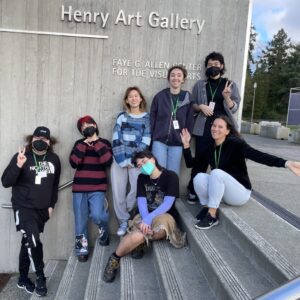 Authors:
Authors:
- Danielle Khleang, she/her, Programs Manager, Henry Art Gallery, University of Washington, Seattle campus
- Em Chan, he/they, Curatorial Assistant, Henry Art Gallery, University of Washington, Seattle campus
Project Description
The Henry Art Liaison program is a three-quarter credited and paid internship program open to University of Washington students of any major. The program uses the lenses of equity, antiracist museum practices, and collaborative learning to introduce selected Henry Art Liaisons to contemporary art interpretation and community engagement within the museum setting. Building on the idea that everyone’s life and learning can be enriched through dialogue with contemporary art, Henry Art Liaisons receive mentorship and training to lead dynamic, community-centered engagements. With museum tours as the cornerstone of the program, these and other engagements are pathways for school and student groups, intergenerational audiences, and the general public to connect with the concepts and conversations found within the museum’s exhibitions and beyond in the larger arts ecology of Seattle. With guidance, the interns take the lead in delivering museum tours for the general public, older adults 55+, and a community group of their choosing.
While special topics of the year-long program rotate with the Henry’s exhibitions, the core learning outcomes for liaisons include:
- A foundational understanding of current debates surrounding the role and implications of museums in society
- Growing art interpretation and visual analysis skills that critically connect visual culture to sociopolitical and personal events
- Internship-level experience facilitating community-centered museum engagements
- Behind-the-scenes knowledge of museum operations across departments
- Increased public speaking and project execution capabilities through experience and training
Project Question
The teaching challenge the Henry is addressing is the perception of museums as institutions that value one-way transmission of knowledge from the expert to the visitor, and perpetuate the idea that art can only be understood and engaged in one way by a specially educated group of people. Instead, the Henry Art Liaison Program approaches new methods of learning by creating a collaborative learning style for the students in the program that is mirrored in their interactions with museum visitors.
Context
The program is a credited and paid internship program open to University of Washington students of any major offered jointly through the Henry Art Gallery and the School of Art, Art History, and Design. The students work in a hybrid setting and meet onsite for classes, 1:1 professional development mentoring, and project support. They design, script, and lead conversation-based tours that invite visitors to co-create knowledge about art by relating their lived experiences to the exhibitions.
Methods
The program creates accessible experiences that value multi-directional flows of exchange and the co-creation of knowledge by centering project-based, collaborative learning. The students are given frameworks to ideate and deliver their engagements rather than being instructed on what to share with visitors. It is essential that students lead these tours because they are less inhibited by institutional structures and produce varied learning journeys for visitors. They shape the course content by leading class discussions and quarterly reflections that produce recommendations for successive quarter content. Because the program is open to students of any major, it fosters interdisciplinary interpretations and approaches to art education.
Impact/Assessment
This program positively impacts student learning by providing opportunities for them to lead and shape their education as well as networking and professional development opportunities that students would not have access to in traditional classroom settings. Students are encouraged to bridge the gap between the museum and the public by applying concepts from their academic training and integrating them into interdisciplinary and accessible conversations with the public sparked by the Henry’s exhibitions. Program participants have reported that the process of translating academic concepts for a general audience has changed their approaches to learning in other classroom settings. Additionally, the focus on project-based collaborative learning gives students real-world experience they will encounter after graduating. Discussions with other Henry staff and leaders in the Seattle arts ecology provide perspectives on career possibilities and pathways for the interns before they enter the job market post-graduation. We measure success qualitatively through bi-weekly check-ins in which students set their own goals, reflect on their progress, and chart steps to achieve their goals. Each is allowed to shape their own experience and trajectory through the program. A pass-fail-incomplete grading scale subverts the way that work is valued in the classroom, instead emphasizing experience and growth.
Application
The Henry Art Liaison Program emphasizes the importance of small group learning that centers collaboration, conversation, and projects. The students are given the authority to regularly facilitate class discussions and select their course work within the parameters of the program. This agency and responsibility to be collaborators in their learning equips them with leadership, presentation, and project management skills – all of which are applicable to other disciplines and sectors. Though this method takes some control away from the instructor, it allows for a greater possibility of ideas to emerge in relation to the course material as well as better prepares the students with soft skills to be successful professionally after graduating. Encouraging practical application of skills and concepts gained from their broader academic training reinforces the learning that students receive and illuminates how this method of knowledge production can be transferrable across many settings, not only within their discipline. Creating more hands-on and public-facing opportunities to do varied types of work related to academic disciplines and interests is a useful professional development tool that will help support structures for students as they embark on their career journeys.